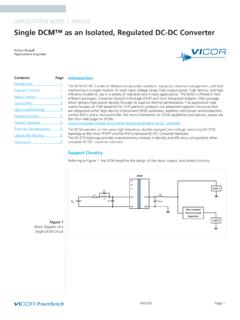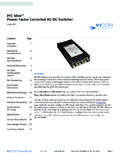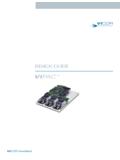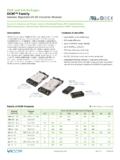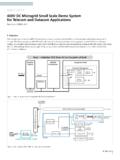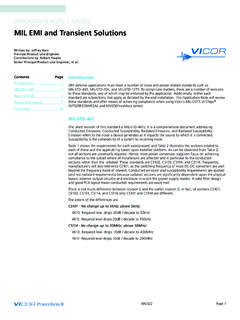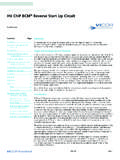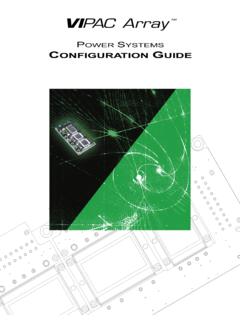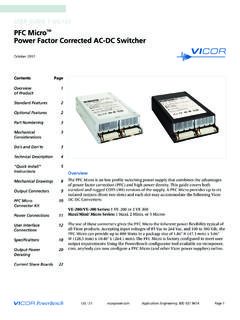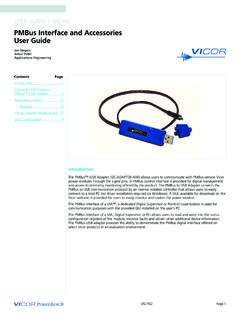Transcription of AN Designing High-Power Arrays - Vicor Corporation
1 AN:207 Page 1 Designing High-Power Arrays Using Maxi, mini and Micro Family DC-DC ConvertersIntroductionVicor s Maxi, mini and Micro DC-DC converters are designed for easy paralleling to increase output power . The unique paralleling interface allows multi-kW capable designs to be implemented with few external components. For information on paralleling up to 12 modules, see the Application Note: Converter PR Pin Facilitates Parallel Operation for power Expansion or Redundancy. For very High-Power Arrays of more than 12 modules, buffering of the PR signal is required as the fan-out limit of the communication bus is reached. This note describes how to use buffering to increase the capability of the bus to drive large numbers of converters, and gives an example of how to quickly prototype a multi-kW system. This allows the benefits of the Maxi, mini and Micro family to be applied for systems with output power into the multi-kW Bus ArchitectureMaster / Slave ConfigurationsOne of the first decisions that must be made when Designing large Arrays is to define the number of master modules.
2 Large numbers of possible masters will increase redundancy but complicate PR and +S/ S line busing. Initially it may be tempting to configure all modules in a democratic array , but this may become cumbersome for Arrays of greater than three modules. For large Arrays a better choice is to define up to three modules as masters and add additional slaves for more power . This provides adequate redundancy for most Across Multiple BoardsIt is often necessary to break an array of converters into multiple PC boards due to space and thermal requirements. Separation between boards will introduce additional impedance between the converters because of added lead/trace length. To keep interconnect impedance between boards from corrupting the control signals, Vicor s PR isolation transformer ( Vicor P/N 29768) must be used to isolate the PR bus. It is recommended that all masters be located on the same board. This keeps noise and line delay between the masters to a minimum.
3 This is especially important for very large Arrays that will be subject to high dI/dts and dV/dts. If an application requires redundancy between boards or between more than twelve modules, a bidirectional buffer must be implemented. This is beyond the scope of this PR signal should be bussed between boards with a relatively lossy low-inductance connection. Twisted pair works well while coaxial cable is not appropriate. Reflections caused by the mismatch of PR bus source, load, and cable impedance will not be damped by the low-loss coaxial cable and result in reduced quality of the PR buffering may be required with large Arrays or if the distance between modules is greater than a few inches. This is because all modules, except the one that s talking, are in the listening mode. Each listener presents a load to the master (talker) of approximately 500 shunted by 30 pF; see Figure 1. Long leads for the interconnection introduce losses and parasitic reactance on the bus that can attenuate and distort the sync-pulse signal.
4 The bandwidth of the bus must be at least 60 MHz. Introduction 1PR Bus Architecture 1 Distribution Across Multiple Boards 1 Buffering 1 Bypassing 25kW, 1,000 Amp Example array 2 Initial System Testing 5 Summary 10 APPLICATION NOTE | AN:207 Contents Page AN:207 Page 2 One simple and robust PR buffer scheme is shown in Figures 2 and 3. The system is separated into one master board (Figure 2) and a number of slave boards (Figure 3). The master board consists of five modules. Two of these are configured in a democratic array with one trimmed down by 2% relative to the other. These modules drive two buffers. The first buffer (Q2) drives three additional slave modules on the master board. The second drives the slave boards. Each slave board contains five modules that are configured as slaves by tying their SC pins to S.
5 There is a PR isolation transformer on each slave wboard that isolates the incoming PR signal. This signal is then buffered and fed to each slave module. The buffers are basic emitter followers that use general-purpose NPN transistors. Transformers labeled T1 have 1:1 turns ratios and can be implemented by using Vicor s PR isolation transformer with one coil left open circuited. Transformers labeled T2 have turns ratios of 2:1 to give better matching to the PR distribution bus. The return path for each transformer or buffer must be Kelvin connected to the IN pin of the appropriate converter. An 8V auxiliary supply gives sufficient headroom for the followers. It is a low- power rail that can be derived from a higher voltage using a linear regulator. A separate auxiliary supply must be derived on each board so that PR bus isolation is maintained. The high frequency bypassing directly at each buffer is essential. Because of the high speed of the PR signal careful attention must be paid to the signal fidelity of the PR bus.
6 Locations for both series and shunt damping resistors or ferrite beads should be included in the layout as shown in Figures 2 and 3. Populating all of these components may not be necessary for all Arrays depending on the geometry of the PR bus. Both master and slave modules should have reverse-polarity protection diodes (D1) on the PR of bypassing components has important consequences for stability and EMI performance of High-Power Arrays . Common-mode bypassing for each converter should be implemented as shown in the Maxi, mini and Micro Design Guide and Applications bypassing can be considered in two parts. Low-frequency bypassing that keeps source impedance low and stabilizes the converter s voltage loop and high -frequency bypassing that reduces switching related EMI. Low-frequency bypassing should be done according to the Design Guide. array input impedance is the individual converter negative input impedance divided by the number of converters in the array .
7 This can present a challenge for very large low-input-voltage Arrays where impedances must be kept very , 1,000 Amp Example ArrayThe following prototype was implemented with modules placed on evaluation boards and connected as shown in Figures 2 and 3. It uses 25 modules with part number V300B5C200B operating in parallel. The array has a 300V input, 5V 1000A output, and is connected in a 5 x 5 array . Output leads must be very heavy gauge so as to have sufficient ampacity to safely carry the high output currents. To reduce the chance of noise causing the masters to swap control, R5 is configured for 2% trim down. When using Micro family converters in parallel Arrays it is imperative that the output voltage of each master is trimmed a minimum of 2% 1 PR Pin Equivalent CircuitPCPR IN+INCINT30pF (typ.)RINT500 (typ.)Pulse DetectorQ16V (Limited to < 150mA)PR LogicMaxi, mini or Micro DC-DC Converter AN:207 Page 3+S+OUTSC S OUT INPRPC+IN(V300B5C200B) Master 1 Bypassing Not Shown (See Figure 4)F1D233 @ 100 MHz1N4148R4430 R4R2NP+ Board Input Board Input+ Board Output Board OutputR1 75 8V RTN_MQ1+8V RTN+PR Bus PR BusT2+S+OUTSC S OUT INPRPC+IN(V300B5C200B) Master 2F1D233 @ 100 MHz Z11N4148R4R2 NPR1 75 Q2C1200nF8V RTN_M2N2222T1 Ferrite BeadFerrite BeadD11N4148R60 +S+OUTSC S OUT INPRPC+IN(V300B5C200B)Slave 1F1D2Z1 10 1N4148R3430 R4430 D11N4148T1+S+OUTSC S OUT INPRPC+IN(V300B5C200B)Slave 2F1D2Z1 10 1N4148R3430 R3430 D11N4148T1+S+OUTSC S OUT INPRPC+IN(V300B5C200B)Slave 3F1D2Z1 10 1N4148D11N4148EN RTNG roup Enable / DisableR549 k+8V 430 1:11:11:11:2432165436543654365 Figure 2 Prototype array Master Board, One Per System AN.
8 207 Page 4+S+OUTSC S OUT INPRPC+IN(V300B5C200B)Slave 1 Bypassing Not Shown (See Figure 4)F1D21N4148+ Board Input Board Input+ Board Output Board Output+S+OUTSC S OUT INPRPC+IN(V300B5C200B)Slave 2F1D21N4148T1+S+OUTSC S OUT INPRPC+IN(V300B5C200B)Slave 3F1D2Z1 10 1N4148R3430 D11N4148T1+S+OUTSC S OUT INPRPC+IN(V300B5C200B)Slave 4F1D2Z1 10 1N4148R3430 D11N4148T1+S+OUTSC S OUT INPRPC+IN(V300B5C200B)Slave 5F1D2Z1 10 1N4148R3430 D11N4148T1Z1 10 R3430 D11N4148R1 0 D11N4148R3430 Z1 10 C1200nF8V RTN_S1R60 +8V +PR Bus PR BusNPR2EN RTNG roup Enable / Disable1:11:11:11:2T24321654365436543654 365 Figure 3 Prototype array Slave Board, Four Per System AN:207 Page 5 Figure 4 Differential-Mode and Common-Mode Bypassing for 5kW array , Each ModuleThe PC pins of the converters have been diode OR d to provide group enable / disable for the array . An external control circuit such as a microprocessor can provide this signal. At a minimum, group undervoltage / overvoltage lockout is required, see the Vicor application note: Undervoltage / Overvoltage Lockout.
9 Because of voltage drops between input leads of individual boards an optocoupler must be used to correctly drive the PC and common-mode bypass capacitors were added close to each converter as shown in Figure 4. In addition, a 24 F capacitor in series with damping resistor was added across the input of the entire array . See Page 7 for information on how these values were chosen. Note: The High-Power capability of the array s input source make proper safety precautions vital. Individual fusing is required for each converter as directed by the Design Guide and Applications Manual. If the array is supplied by an offline source an isolated scope should be used when making input side measurements. Never apply power to an array without connecting the output of the master board and all slave boards to the same point. Failure to do so will cause a destructive output overvoltage System TestingEven the best array design will not predict all parameters that will impact performance.
10 Thorough testing during the prototyping phase is recommended so that optimal component values can be determined and potential issues avoided. Tests may include dynamic loading, checking input and output ripple, phase gain analysis, and PR bus signal fidelity. For safety and to simplify testing, initial power up should be performed on a subset of modules. For example, the master board of the above array was tested first and the system was subsequently checked as each new slave board was Signal FidelityOptimal component values for damping the PR bus were found by testing the master board and one slave board (ten modules total). The PR bus should always be checked with an oscilloscope even if the array appears to behave 5 shows the initial PR signal with series damping resistors / ferrite beads (Z1), and shunt damping (R3, R4) removed. This displays undesirable ring up due to parasitic L and C. This pulse violates the 7V absolute maximum rating on the PR pin.
